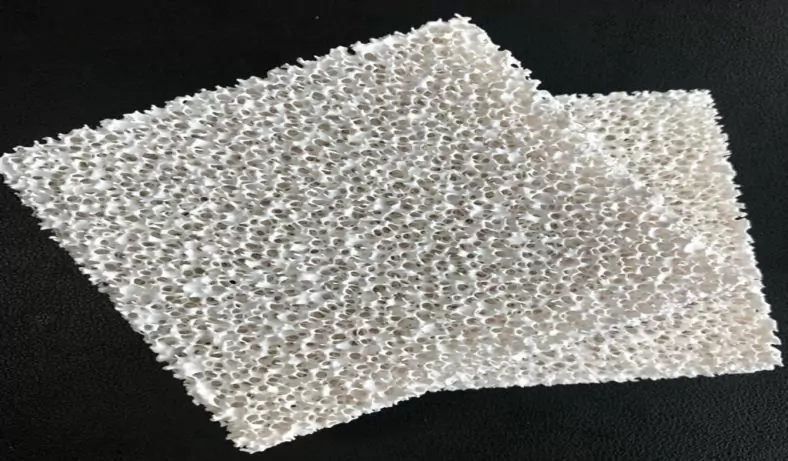The properties of the material itself actually determine its application to a large extent. For example, the heat transfer performance of most ceramic materials is worse than that of metal materials, so the application in the field of heat conduction is not as much as that of metal materials.

Metal Plates and Ceramic Plates
But even so, because ceramic materials have high melting point, high hardness, high wear resistance, oxidation resistance, corrosion resistance and excellent properties in sound, light, electricity, heat, magnetism, etc., in certain occasions, thermal conductivity Better and insulating ceramics can also play a role in replacing metals, generally oxides, nitrides, carbides, borides, etc., such as AlN, BeO, Si3N4, SiC, BN, etc. In recent years, the application of these high thermal conductivity ceramics has become very extensive, the most well-known of which is the ceramic substrate.
Heat Transfer Principle Of Thermally Conductive Ceramics
The heat conduction process is the energy transmission process inside the material, but the energy transmission is not transmitted along a straight line from one end of the object to the other end, but in the form of diffusion, which will deviate from the straight line direction due to collision during the propagation process. The loaders of thermal energy are electrons, phonons, photons and magnetic excitations.
Since ceramics are covalent compounds, the internal electrons are bound and cannot move freely, so their thermal conduction is achieved by the mutual restriction or mutual harmonic vibration of the crystal structure units (atoms, ions or molecules). When the lattice is intact and defect-free, the larger the mean free path of the phonons, the higher the thermal conductivity. Generally, non-metallic materials with high thermal conductivity have the characteristics of simple crystal structure, lattice defects, less impurities and voids, and high Debye temperature.
Influencing Factors Of Ceramic Materials Thermal Conductivity
Although the characteristics of high thermal conductivity ceramics have been explained above, in practical industrial applications, the crystals will be more or less defective, and the distribution of their structural elements will also be different. Therefore, in addition to the inherent phonon-phonon scattering that reduces the thermal conductivity of aluminum nitride ceramics, various defects in the ceramics are the main factors affecting the thermal conductivity. Let’s take AlN ceramics as an example to list the annoying defects that affect its thermal conductivity.
Aluminum Nitride Ceramic Substrate
1. Oxygen Impurities
As with all solid dielectrics, aluminum nitride’s thermal conductivity is adversely affected by lattice impurities, the predominant of which is lattice oxygen. Based on its single crystal research, Slack proposed that oxygen atoms would dissolve into the aluminum nitride lattice. Since oxygen atoms and nitrogen atoms are non-equivalent substitutions, according to the defect equation, one aluminum will be vacant with three oxygen atoms. The following defect equation shown:
This results in the generation of a large number of aluminum lattice sites and aluminum vacancies, which makes the aluminum nitride lattice show anharmonicity, which affects the phonon scattering, thereby sharply reducing the thermal conductivity of aluminum nitride ceramics. Bachelard et al. showed that when the oxygen content in aluminum nitride is 0.12wt%, its thermal conductivity drops to 185W/(m K), and when the oxygen content increases to 0.31wt%, its thermal conductivity is only 130W /(m·k).
2. Density
According to the thermal conductivity of aluminum nitride, the presence of a large number of pores in low-density samples will affect the scattering of phonons, reduce their mean free path, and then reduce the thermal conductivity of aluminum nitride ceramics. At the same time, the mechanical properties of low-density samples may not meet the relevant application requirements. Therefore, high density is a prerequisite for aluminum nitride ceramics to have high thermal conductivity.
3. Microstructure
In the sintering process of aluminum nitride ceramics, some additives are often added to reduce the sintering temperature of aluminum nitride ceramics. However, the second phase generated at the same time may exist in the aluminum nitride lattice, and it will also scatter during the thermal conduction process of aluminum nitride, thereby affecting the thermal conductivity of aluminum nitride ceramics. The distribution of the second phase in the aluminum nitride lattice mainly has two forms, one is distributed at the grain boundary, which is a continuous phase distribution, and the other is distributed at the grain boundary triangle, which is an isolated phase distribution.
It can be seen from the figure that compared with the aluminum nitride ceramics with the second phase distributed at the grain boundary, the aluminum nitride ceramics with the second phase distributed at the grain boundary triangle has better thermal conductivity, because the latter is in the aluminum nitride heat conduction process. There is less coherent scattering in . The above picture is a microscopic model of the different distribution of the second phase in the aluminum nitride ceramic, which vividly shows that the second phase located at the grain boundary triangle has less influence on the heat conduction of aluminum nitride than at the grain boundary.
In Summarize
On the whole, in order to improve the thermal conductivity of ceramic materials, the following methods can be used: try to improve the purity of ceramic materials, try not to add or add additives, but in order to improve the density of the material and control the grain size, add a certain amount of additive Proper control of the particle size of the raw material can significantly increase the thermal conductivity; increase the density of the ceramic material, reduce the pores and glass phase, and make it as close to the theoretical density as possible, and so on.
Research on Low Temperature Sintering High Thermal Conductivity Aluminum Nitride Ceramics and Their Thermal Conductivity, Yang Qinghua.Research status and prospect analysis of high thermal conductivity ceramic materials, Jiang Qiming, Huang Huining, Meng Qingjuan, Zhang Wanglin, Huang Xinchen, Zhang Guotao.
